Owlman
Seedling
I thought I would share my 6 years of experience searching for a lesser known native species of Elm in Michigan. Michigan has been described in the literature as the "bedrock" of the species Ulmus thomasii, commonly called the Rock Elm. In the early 1900's, we had large populations of these trees throughout the state. Heavy timber harvesting during the first few decades of the 20th century combined with the introduction of Dutch Elm disease by the early 30's led to the absolute decimation of Rock Elm across America. Some tree species that suffer disease outbreaks quickly recover via human intervention, natural genetic mutations or a crash in the pathogen vector population. Ulmus thomasii has a myriad of reasons why it has never recovered:
1. Elm bark beetles have numerous other Elm species from which they can sustain their populations with.
2. Rock Elm wood is incredibly dense and strong and is highly valued as lumber.
3. Rock Elm propagates by Mast seeding at 4 or 5 year intervals and won't begin to produce seed until the tree is at least 40 years old.
4. The seeds are very nutritious, tasty (even to humans) and highly sought after by most wildlife and is often completely devoured within 24 hours of falling.
5. The seeds are only viable when kept moist and must germinate immediately after falling to avoid desiccation.
6. Seedlings are also a desired food source for deer and rabbits.
7. The species is incredibly slow growing and only adds about an inch per year for the first few years, leaving them wide open for predators and plant competition.
8. Secondary propagation is by root suckers, which will all die if a single tree is infected with DED as the disease spreads through roots.
9. Lack of knowledge about this species contributes to lack of conservation efforts.
I was extremely interested in this species from the first time I saw it in a book on Native Trees and Shrubs of the Northeastern US. Everything from the unique corky bark, haunting silhouette and fact that I had never heard of the species despite being a graduate in Entomology and Plant Pathology contributed to a burning desire to learn more. After reaching out to the top forestry professors in the state I learned that most of them knew very little about it as well, including where it could be found or how to properly identify it against similar looking species (U. minor, U. alata, U. americana, U. rubra, etc.). I received many comments along the lines of "Rock Elm? Nobody has inquired about that species for quite some time. I'm not sure what to tell you about it. There is little interest in it and I haven't seen any, but maybe reach out to..."
The lack of interest from the community started me on a 6 year journey to find some trees.
I began in 2018 by looking up every botanical record from the major Universities across the state, delving into online forums and anywhere people said they saw them, and visiting each location to see if I could find the trees. 2018 was my busiest year and I visited almost a hundred locations. Most of the time, the tree was misidentified. Unfortunately many other species of Elm can exhibit corky outer bark under particular circumstances or as a result of genetic variability and most people will see that characteristic and immediately assume it is a Rock Elm.
Here is a tree I thought was a Rock Elm until it produced samaras and I discovered it was in fact a Field Elm (U. minor), introduced to America roughly 100 years ago. Note the extremely corky bark and very similar bud structure.
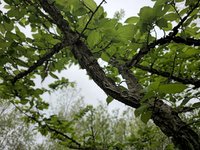
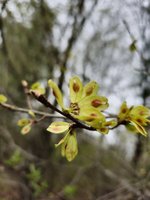
The only precise way of identifying it is from the seeds (samaras) and to a lesser extent, the buds. Given the trees don't seed every year and on years that they do, it is only around for a few weeks, this makes finding them very difficult. In 2018 I found two sites that I believed had Rock Elm. One of the sites, miraculously, was producing seeds. I waited a week for them to mature and returned to find only 10 or so seeds were still left on the tree. Hundreds of seeds were scattered across the base of the tree, all of which had been opened and the seed removed. Upon closer inspection, I noticed ants were all over the ground chewing the samara open and hauling the seed away. I quickly collected the few seeds that I could and in doing so, noticed an ant on one of the samaras in the tree actively chewing the connection point of the samara and holding onto the pod as it fell off the tree. I wish I had gotten it on video. The whole experience reinforced my theory that this species has a terrible struggle to overcome for its seeds to survive and germinate. I took the seeds home and followed the instructions from "Growing Trees from Seed: A Practical Guide to Growing Native Trees, Vines and Shrubs" by Henry Kock. I noticed that out of the 10 seeds I had, only one of them was plump in size. The others were thin. The plump seed was the only one of the ten to germinate, but unfortunately shortly after the root emerged from the samara, the samara got moldy and the seedling soon turned brown and died before it could burst from the samara casing.
From 2019 to 2021 I visited even more locations and even went outside the state a bit to look. I found one other location in Ohio and also revisited both confirmed Michigan locations again, but each of these years none of the locations were producing seed.
In 2022 I lucked out and all three locations were seeding again at the same time. Weather conditions and timing must have been perfect in the northeast for a Masting year. I found stiff competition from insects and chipmunks at each location as usual but the seeds all looked very plump and promising.
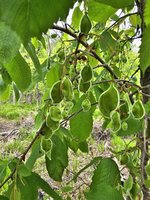
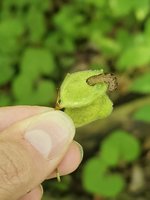
I collected seeds early to avoid them all being eaten again and went home to germinate them. I decided to remove the inner seed from the samara this time to discourage mold from forming during the process. When removing the seeds I found them all to be thin and premature. I had collected too early and in the end none of them germinated. I rushed back the following weekend to all three sites and found most were eaten again. Ants everywhere, particularly at the Ohio site. They were all over in the trees chopping the pods off. I had to drive many hours and do a bit of tree climbing but when it was all said and done I had collected about a hundred mature seeds spread across the three sites. I removed them from the samaras again, which took some time. Most were plump and round. This time I had about a 50% success rate and the sprouted seeds went into pots.
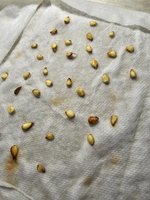
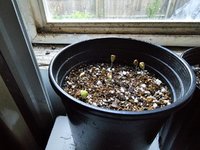
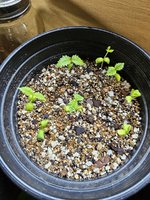
For the first year they only produced one set of true leaves and were all roughly 1 inch tall. I did not want to risk fertilizer burn on new seedlings and have to wait another 4 years to get more seeds, so I avoided fertilizing them in 2022. Out of my 50 or so seedlings, 10 did not break bud in 2023. They were too small/weak and died over the winter.
I got another inch of growth out of the remaining seedlings in 2023 despite fertilizing them this time. They looked much greener and the leaves were larger but only another inch of wood was created.
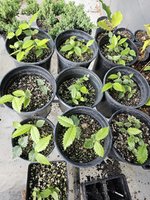
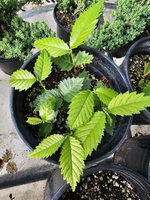
Starting off this 2024 spring, the stems were 2 inches or so tall, but after emerging I have about 2 inches of growth on the shoots already which is a huge relief. I read how slow these are to grow, but holy cow they really are slow. I plan to fertilize well this year and hope for some good progress this year. The bases of the seedlings are quite thick for their length and have good taper to them. Rock Elm produce a long taproot, like Oaks. I am going to move most of them to deep pots and allow the taproot to grow because these I plan to plant in the ground on certain properties to get some more native tree populations established and help out the species numbers. Some I will remove the taproot (likely next spring) and begin to work into eventual pre-bonsai material. Since I have yet to see a single Rock Elm sapling out in the wild (all have been just 1 or 2 large trees), Yamadori is highly unlikely and I don't think I would even attempt it if I did for fear that it would die and I would have taken out one of the few Rock Elms to make it that far in the wild.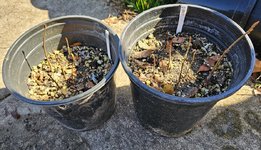

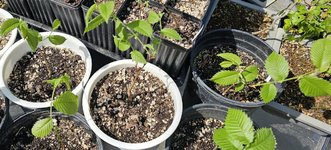
I keep visiting new areas and have found an additional location in Michigan with a nice stand of 6 or so trees at seed producing age. I've noticed they are nearly always in underdeveloped areas and off the beaten path so to speak, which might explain why nobody knows where they are. I have a feeling there are a good number of small pockets of trees that survived DED or are offspring of the large ones that DED took out, just now reaching seed producing maturity. It really is just a matter of finding them which will take many hours of hiking around the state. Its a hobby of mine so I actually like the hunt. One of the Michigan locations that I gathered seed from in 2022 was from a tree that has serious state Champion potential. Hard to imagine there is a bigger one out there but I'm sure there might be. It's good to know my seedlings came from excellent stock.
Congrats if you made it this long. Hopefully you enjoyed the read. If this species interests you as well, go out there and look for some in your area. There are still old growth populations in Canada, Minnesota and Wisconsin as well as some pockets here and there in Indiana, Ohio and some a bit south of there as well. Remember, its the seed samara that is the only real dead giveaway so don't prematurely get your hopes up like I did. Take your time and enjoy getting outdoors. Hopefully this species finds a way to recover and establish itself again as the gorgeous specimens they once were. Absolutely perfect characteristics for bonsai by the way
1. Elm bark beetles have numerous other Elm species from which they can sustain their populations with.
2. Rock Elm wood is incredibly dense and strong and is highly valued as lumber.
3. Rock Elm propagates by Mast seeding at 4 or 5 year intervals and won't begin to produce seed until the tree is at least 40 years old.
4. The seeds are very nutritious, tasty (even to humans) and highly sought after by most wildlife and is often completely devoured within 24 hours of falling.
5. The seeds are only viable when kept moist and must germinate immediately after falling to avoid desiccation.
6. Seedlings are also a desired food source for deer and rabbits.
7. The species is incredibly slow growing and only adds about an inch per year for the first few years, leaving them wide open for predators and plant competition.
8. Secondary propagation is by root suckers, which will all die if a single tree is infected with DED as the disease spreads through roots.
9. Lack of knowledge about this species contributes to lack of conservation efforts.
I was extremely interested in this species from the first time I saw it in a book on Native Trees and Shrubs of the Northeastern US. Everything from the unique corky bark, haunting silhouette and fact that I had never heard of the species despite being a graduate in Entomology and Plant Pathology contributed to a burning desire to learn more. After reaching out to the top forestry professors in the state I learned that most of them knew very little about it as well, including where it could be found or how to properly identify it against similar looking species (U. minor, U. alata, U. americana, U. rubra, etc.). I received many comments along the lines of "Rock Elm? Nobody has inquired about that species for quite some time. I'm not sure what to tell you about it. There is little interest in it and I haven't seen any, but maybe reach out to..."
The lack of interest from the community started me on a 6 year journey to find some trees.
I began in 2018 by looking up every botanical record from the major Universities across the state, delving into online forums and anywhere people said they saw them, and visiting each location to see if I could find the trees. 2018 was my busiest year and I visited almost a hundred locations. Most of the time, the tree was misidentified. Unfortunately many other species of Elm can exhibit corky outer bark under particular circumstances or as a result of genetic variability and most people will see that characteristic and immediately assume it is a Rock Elm.
Here is a tree I thought was a Rock Elm until it produced samaras and I discovered it was in fact a Field Elm (U. minor), introduced to America roughly 100 years ago. Note the extremely corky bark and very similar bud structure.


The only precise way of identifying it is from the seeds (samaras) and to a lesser extent, the buds. Given the trees don't seed every year and on years that they do, it is only around for a few weeks, this makes finding them very difficult. In 2018 I found two sites that I believed had Rock Elm. One of the sites, miraculously, was producing seeds. I waited a week for them to mature and returned to find only 10 or so seeds were still left on the tree. Hundreds of seeds were scattered across the base of the tree, all of which had been opened and the seed removed. Upon closer inspection, I noticed ants were all over the ground chewing the samara open and hauling the seed away. I quickly collected the few seeds that I could and in doing so, noticed an ant on one of the samaras in the tree actively chewing the connection point of the samara and holding onto the pod as it fell off the tree. I wish I had gotten it on video. The whole experience reinforced my theory that this species has a terrible struggle to overcome for its seeds to survive and germinate. I took the seeds home and followed the instructions from "Growing Trees from Seed: A Practical Guide to Growing Native Trees, Vines and Shrubs" by Henry Kock. I noticed that out of the 10 seeds I had, only one of them was plump in size. The others were thin. The plump seed was the only one of the ten to germinate, but unfortunately shortly after the root emerged from the samara, the samara got moldy and the seedling soon turned brown and died before it could burst from the samara casing.
From 2019 to 2021 I visited even more locations and even went outside the state a bit to look. I found one other location in Ohio and also revisited both confirmed Michigan locations again, but each of these years none of the locations were producing seed.
In 2022 I lucked out and all three locations were seeding again at the same time. Weather conditions and timing must have been perfect in the northeast for a Masting year. I found stiff competition from insects and chipmunks at each location as usual but the seeds all looked very plump and promising.


I collected seeds early to avoid them all being eaten again and went home to germinate them. I decided to remove the inner seed from the samara this time to discourage mold from forming during the process. When removing the seeds I found them all to be thin and premature. I had collected too early and in the end none of them germinated. I rushed back the following weekend to all three sites and found most were eaten again. Ants everywhere, particularly at the Ohio site. They were all over in the trees chopping the pods off. I had to drive many hours and do a bit of tree climbing but when it was all said and done I had collected about a hundred mature seeds spread across the three sites. I removed them from the samaras again, which took some time. Most were plump and round. This time I had about a 50% success rate and the sprouted seeds went into pots.



For the first year they only produced one set of true leaves and were all roughly 1 inch tall. I did not want to risk fertilizer burn on new seedlings and have to wait another 4 years to get more seeds, so I avoided fertilizing them in 2022. Out of my 50 or so seedlings, 10 did not break bud in 2023. They were too small/weak and died over the winter.
I got another inch of growth out of the remaining seedlings in 2023 despite fertilizing them this time. They looked much greener and the leaves were larger but only another inch of wood was created.


Starting off this 2024 spring, the stems were 2 inches or so tall, but after emerging I have about 2 inches of growth on the shoots already which is a huge relief. I read how slow these are to grow, but holy cow they really are slow. I plan to fertilize well this year and hope for some good progress this year. The bases of the seedlings are quite thick for their length and have good taper to them. Rock Elm produce a long taproot, like Oaks. I am going to move most of them to deep pots and allow the taproot to grow because these I plan to plant in the ground on certain properties to get some more native tree populations established and help out the species numbers. Some I will remove the taproot (likely next spring) and begin to work into eventual pre-bonsai material. Since I have yet to see a single Rock Elm sapling out in the wild (all have been just 1 or 2 large trees), Yamadori is highly unlikely and I don't think I would even attempt it if I did for fear that it would die and I would have taken out one of the few Rock Elms to make it that far in the wild.



I keep visiting new areas and have found an additional location in Michigan with a nice stand of 6 or so trees at seed producing age. I've noticed they are nearly always in underdeveloped areas and off the beaten path so to speak, which might explain why nobody knows where they are. I have a feeling there are a good number of small pockets of trees that survived DED or are offspring of the large ones that DED took out, just now reaching seed producing maturity. It really is just a matter of finding them which will take many hours of hiking around the state. Its a hobby of mine so I actually like the hunt. One of the Michigan locations that I gathered seed from in 2022 was from a tree that has serious state Champion potential. Hard to imagine there is a bigger one out there but I'm sure there might be. It's good to know my seedlings came from excellent stock.
Congrats if you made it this long. Hopefully you enjoyed the read. If this species interests you as well, go out there and look for some in your area. There are still old growth populations in Canada, Minnesota and Wisconsin as well as some pockets here and there in Indiana, Ohio and some a bit south of there as well. Remember, its the seed samara that is the only real dead giveaway so don't prematurely get your hopes up like I did. Take your time and enjoy getting outdoors. Hopefully this species finds a way to recover and establish itself again as the gorgeous specimens they once were. Absolutely perfect characteristics for bonsai by the way


